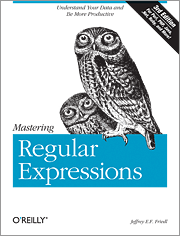|

|
Mastering Regular Expressions has been around for a long time — this is the third edition of a book originally published a decade ago. Does that actually reflect justified popularity, or is it just that this is the only book-length treatment of the various regex engines, how they differ, and how to get the most out of them? I'm glad to say that doesn't seem to be case: if you use regexes in any depth at all, you should probably read this book.
The tight integration of regular expressions into the rest of the language is one of the defining characteristics of Perl. It also tends to inform idiomatic Perl code: a lot of Perl code can (and does) make full use of all the facilities of the regex engine. But many programmers treat advanced use of regexes as a bit of a black art, relying perhaps on cargo-culting as a problem-solving approach (or even the ever-popular technique of editing randomly till it seems to work).
Part of the problem is that tutorial-style books typically don't have enough space to do full justice to the capabilities of regexes, while reference texts typically cover the details of each feature, without analysing what you can actually accomplish with them. This is precisely the gap that Mastering Regular Expressions attempts to fill, offering full, in-depth coverage of everything you need to know to get the most out of your regexes.
The two opening chapters are aimed mainly at novices, though they can also be good review material for more experienced readers seeking to clarify or confirm their understanding. Chapter 1 starts by looking at what sorts of things regexes can do, and the syntaxes used; it introduces a useful mental model for thinking about regexes. Friedl looks at a real-world example — finding doubled words — right from the start, which is very encouraging. Chapter 2 continues in the same vein, applying regexes to additional realistic tasks. It also begins to look at how to write regex-using code in various programming languages.
Chapter 3 deals with the nitty-gritty details of the various regex
dialects: which features are available in which engines, and the
cross-engine syntactic differences for the features that they all share.
This is definitely useful even for more-experienced readers, especially
those who are mostly familiar with one dialect (say, Perl) but
occasionally need to use another (perhaps that of the traditional Unix
grep(1) utility).
Chapter 4 is perhaps the core of the book in terms of detailed descriptions of how regex engines work. It offers a typology of regex engines (DFA, Traditional NFA, POSIX NFA, or hybrid), looking in detail at how the choice of implementation affects the way your regex is executed. This involves some discussion of the theory behind regexes, but the approach is overwhelmingly practical and pragmatic rather than mathematical. (Indeed, some authors suggest that, if anything, Friedl pays too little attention to the underlying theory.)
Chapter 5 takes the knowledge built up in the previous chapter and applies it to a larger variety of real-world problems — and without avoiding thorny issues that often crop up in practice. Chapter 6 is in much the same vein, but focuses especially on performance: the optimisations that engines apply automatically, and how to craft regexes to take maximum advantage of the way the engine works.
The remaining chapters are rather different: each covers a particular programming language, and the regex facilities offered in that language. Chapter 7 looks at Perl, and is the most detailed; that's not entirely surprising given Perl's tight integration of regexes. The remaining chapters cover Java, .NET, and PHP respectively.
There's much to like about Mastering Regular Expressions. It's certainly a comprehensive analysis of how to get the most out of regexes, especially for Perl programmers. It demonstrates enormous attention to detail; for example, it adopts some simple but clever typographical conventions that eliminate confusion between text that is matched by a regex on the one hand, and the textual representation of the regex itself on the other.
That said, it's not impossible to find things to complain about. At times, it explains things with metaphors that are somewhat too cutesy for my taste (though I can imagine some readers finding them very helpful). A case could also be made that, for a reader whose interest is focussed on any given regex implementation, there's too much coverage of all the others; in particular, Friedl's preference for Perl is obvious. But then, the results are better than having separate books for each major tool, and it can be of interest to look at the different features available in other worlds.
Another potential issue for some is that, for obvious and unavoidable chronological reasons, this edition can't cover the new regex features available in the forthcoming release of Perl 5.10 — or, for that matter, the rather different pattern-matching language that will be part of Perl 6. It would be pleasing for future editions will cover these changes.
Overall, Mastering Regular Expressions is an excellent book. I highly recommend it to all intermediate or advanced Perl programmers, or anyone else who often needs to extract information out of text.
Table of contents
Mastering Regular Expressions 1. Introduction to Regular Expressions 2. Extended Introductory Examples 3. Overview of Regular Expression Features and Flavors 4. The Mechanics of Expression Processing 5. Practical Regex Techniques 6. Crafting an Efficient Expression 7. Perl 8. Java 9. .NET 10. PHP Index
